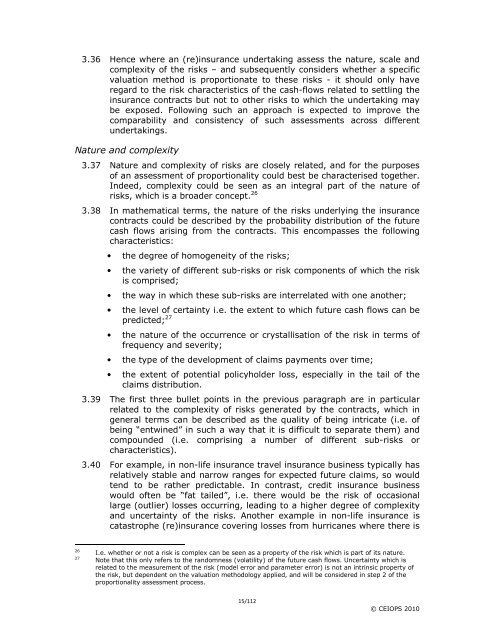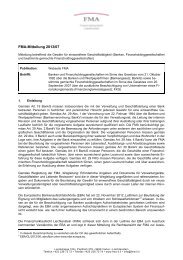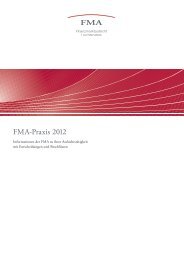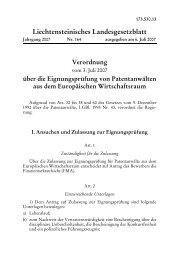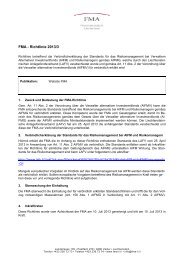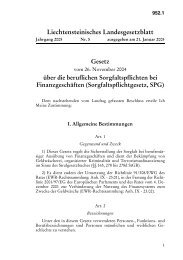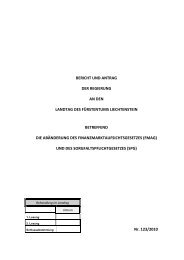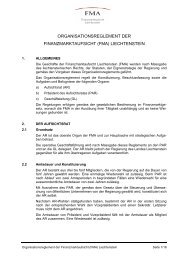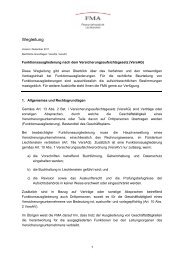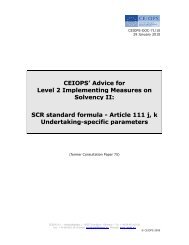CEIOPS' Advice for Level 2 Implementing ... - EIOPA - Europa
CEIOPS' Advice for Level 2 Implementing ... - EIOPA - Europa
CEIOPS' Advice for Level 2 Implementing ... - EIOPA - Europa
You also want an ePaper? Increase the reach of your titles
YUMPU automatically turns print PDFs into web optimized ePapers that Google loves.
3.36 Hence where an (re)insurance undertaking assess the nature, scale and<br />
complexity of the risks – and subsequently considers whether a specific<br />
valuation method is proportionate to these risks - it should only have<br />
regard to the risk characteristics of the cash-flows related to settling the<br />
insurance contracts but not to other risks to which the undertaking may<br />
be exposed. Following such an approach is expected to improve the<br />
comparability and consistency of such assessments across different<br />
undertakings.<br />
Nature and complexity<br />
3.37 Nature and complexity of risks are closely related, and <strong>for</strong> the purposes<br />
of an assessment of proportionality could best be characterised together.<br />
Indeed, complexity could be seen as an integral part of the nature of<br />
risks, which is a broader concept. 26<br />
3.38 In mathematical terms, the nature of the risks underlying the insurance<br />
contracts could be described by the probability distribution of the future<br />
cash flows arising from the contracts. This encompasses the following<br />
characteristics:<br />
• the degree of homogeneity of the risks;<br />
• the variety of different sub-risks or risk components of which the risk<br />
is comprised;<br />
• the way in which these sub-risks are interrelated with one another;<br />
• the level of certainty i.e. the extent to which future cash flows can be<br />
predicted; 27<br />
• the nature of the occurrence or crystallisation of the risk in terms of<br />
frequency and severity;<br />
• the type of the development of claims payments over time;<br />
• the extent of potential policyholder loss, especially in the tail of the<br />
claims distribution.<br />
3.39 The first three bullet points in the previous paragraph are in particular<br />
related to the complexity of risks generated by the contracts, which in<br />
general terms can be described as the quality of being intricate (i.e. of<br />
being “entwined” in such a way that it is difficult to separate them) and<br />
compounded (i.e. comprising a number of different sub-risks or<br />
characteristics).<br />
3.40 For example, in non-life insurance travel insurance business typically has<br />
relatively stable and narrow ranges <strong>for</strong> expected future claims, so would<br />
tend to be rather predictable. In contrast, credit insurance business<br />
would often be “fat tailed”, i.e. there would be the risk of occasional<br />
large (outlier) losses occurring, leading to a higher degree of complexity<br />
and uncertainty of the risks. Another example in non-life insurance is<br />
catastrophe (re)insurance covering losses from hurricanes where there is<br />
26 I.e. whether or not a risk is complex can be seen as a property of the risk which is part of its nature.<br />
27 Note that this only refers to the randomness (volatility) of the future cash flows. Uncertainty which is<br />
related to the measurement of the risk (model error and parameter error) is not an intrinsic property of<br />
the risk, but dependent on the valuation methodology applied, and will be considered in step 2 of the<br />
proportionality assessment process.<br />
15/112<br />
© CEIOPS 2010


